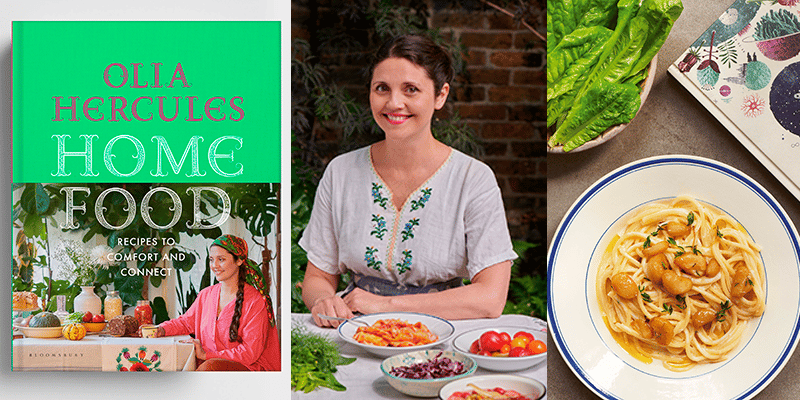For Olia Hercules, cooking is normally her therapy, her safe space – but she lost this when Russia invaded her native country, Ukraine.
“For the first two months or so, I couldn’t really cook – it was a weird feeling,” the 38-year-old remembers. “Normally it’s an act of meditation and stress relief. If it’s a normal, everyday stress, I cook – especially if I make something a bit more involved, like dough, breadmaking, dumplings – something like that, it’s amazing.
“But when you’re going through trauma, it was completely different. I felt guilty eating at first, then I felt guilty cooking. It was a horrible feeling, and I couldn’t shake it off.”
She eventually felt differently while making her parents a meal in Italy after they fled Ukraine. “That’s when it lifted, and I was like yes, I’ve got it back. I’m enjoying making this borscht for them, I know it’s going to do so much good.”
Now, Hercules says she realises cooking is “an act of resistance and defiance, and not letting Putin and his goons take all the joy away from us – because that’s what they’re trying to do”.
Recently, after some particularly bad news about the war, Hercules regressed to those feelings – but her mother brought her back to herself. “She said, ‘This is what he’s [Vladimir Putin] trying to do. Don’t let him do this – this is how we’re going to lose if we’re going to be paralysed by fear all the time and stop living.’ So we can’t stop living – and food is life.”
Now, Hercules is learning to take better care of herself, whether that’s returning to cooking, booking herself into an embroidery course, or writing. She also set up the Cook for Ukraine campaign with friend and food writer Alissa Timoshkina, as a way of raising awareness.
“At first we thought, OK, this is going to be a hashtag, and maybe we’ll think of something – a donation situation,” she says. “We were like, it’s good enough to just do a hashtag, cook a Ukrainian meal, and educate people and keep Ukraine in the news, keep talking about it – and also this thing of connection.”
If somebody in Britain makes a Ukrainian dish, Hercules suggests: “It’s much easier for them to imagine a family that would have been having this dish somewhere in Ukraine – and now they can’t do that anymore. The headlines are there, and with time it’s only natural for people to start disassociating, and being like, OK, I need to preserve my sanity, I can’t look at this horror all the time.
“But having something cultural – especially something to do with food – keeps you connected, and also gives you strength in a way.”
The campaign’s success exceeded Hercules’ expectations, and as well as raising awareness around the situation in Ukraine, it’s also a window into the country’s unique cuisine.
She accepts there are preconceptions about Ukrainian food. “People have said it is all about potatoes and dumplings and overcooked cabbage, which was actually really hurtful. But stereotypes are stereotypes – I don’t blame people for having them.”
Instead, she wants people to know the cuisine is so much more than that – it’s “diverse, and can be fresh and herbaceous”.
Now though, Hercules doesn’t feel like she has to convince everyone that Ukraine is a rich and diverse country. It is – but she also says: “It’s time to embrace all of our potato and cabbage dishes, because they’re actually extremely delicious.”
She has one of these potato dishes in her latest cookbook, Home Food. A staple growing up, the recipe for crispy potatoes and onions is ‘something everybody could do – students do it – and the perfection of this dish is because you cut the potatoes in an imperfect way. [Even if] you’re striving to do really thin slices, inevitably some will be thicker than others – and that’s what you want, that’s what makes it so good. Because some of the potatoes become more crispy, and some become soft.’
Hercules rediscovered the recipe during the start of the pandemic, asking her mum about it (who, by the way, didn’t think it even counted as a recipe) – and now it’s well and truly back in her repertoire.
Through writing her new book, Hercules realised how much food can connect people – regardless of where you come from. Crunchy lettuce is the perfect accompaniment for this dish.
“I don’t normally find much pleasure in cooking for just me. Except when it’s this dish,” says Olia Hercules.
“This is adapted from an old Nigel Slater recipe, a writer who inspired me and so many others to look beyond cookbook recipes and to cook more freely and creatively. I turn to this recipe time and again when I have some moments on my own.”
She always serves lettuce leaves on the side, to mop up the pasta sauce with a bit of crunch.
Ingredients: (Serves 2)
2 small garlic bulbs (yes, that’s correct, 1 per person)
100ml good olive oil
Leaves from 4 thyme sprigs
200g spaghetti or linguine
200g soft goat’s cheese (logs are good)
To serve:
Lettuce leaves
Good vinegar
Sea salt
Method:
1. I haven’t yet found a garlic peeling hack that works. What I do is separate the cloves, then attempt to lightly bash on each with the heel of my hand and cut off the dry root end. The skins then slip off quite easily. If you accidentally squash some (or a lot, like I do, heavy-handedly) of the cloves, don’t worry too much, they can still be used. Put the oil into the smallest saucepan or frying pan you have, heat it gently and spoon in the garlic. The cloves should be submerged in oil and cook very gently over the lowest heat possible.
Sometimes I tilt the pan carefully, helping the cloves to submerge, and stand there holding the pan. But you can always use more oil. It won’t go to waste, as the garlicky oil is so good in other recipes, or to dress boiled vegetables. The garlic will be spluttering away, its water escaping the oil. It has to soften, mellow and colour only ever so slightly. The whole process should take about 20 minutes, but use your judgement. When ready, the garlic will smell very sweet and the cloves can be easily pierced with a knife. Take it off the heat and add the thyme.
2. Cook the pasta according to the packet instructions. Put the goat’s cheese into a food processor. When there are three minutes to go before the pasta is done, ladle 200 millilitres of the pasta water into a measuring jug. Blitz the goat’s cheese with half of the measured pasta water and two to three tablespoons of the garlic oil. You will have a smooth and rather liquid sauce, but do not worry, it will all be good. (If it is not quite liquid, I find the pasta eats too dry.)
3. Drain the pasta and put it back into the pan in which it was cooking. Pour the sauce over the pasta and, using tongs, pick the pasta up and down, making sure to cover the pasta in the sauce. Keep agitating it like this for a minute. At this point I take a mouthful and check if it slips down smoothly. If it feels a bit dry rather than slippery, I add another splash of pasta water and swirl it around with tongs some more.
4. Put the pasta into serving plates and pour over any goat’s cheese sauce that remained behind in the pan. Serve with the confit garlic cloves scattered over the top and a drizzle of the garlic oil.
5. When you finish the pasta, pile the lettuce leaves directly into the pasta plate and add a little vinegar and salt. The remainder of the goat’s cheese sauce is so good with the leaves.








